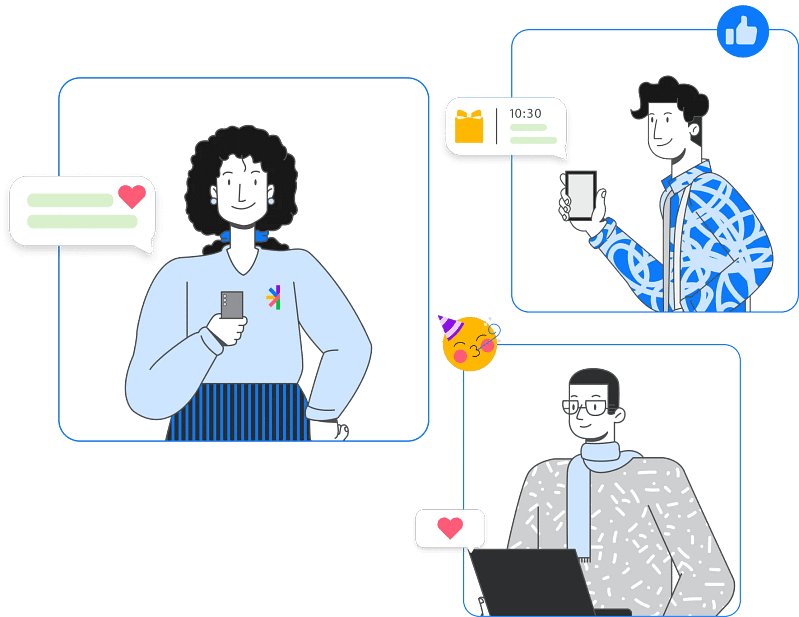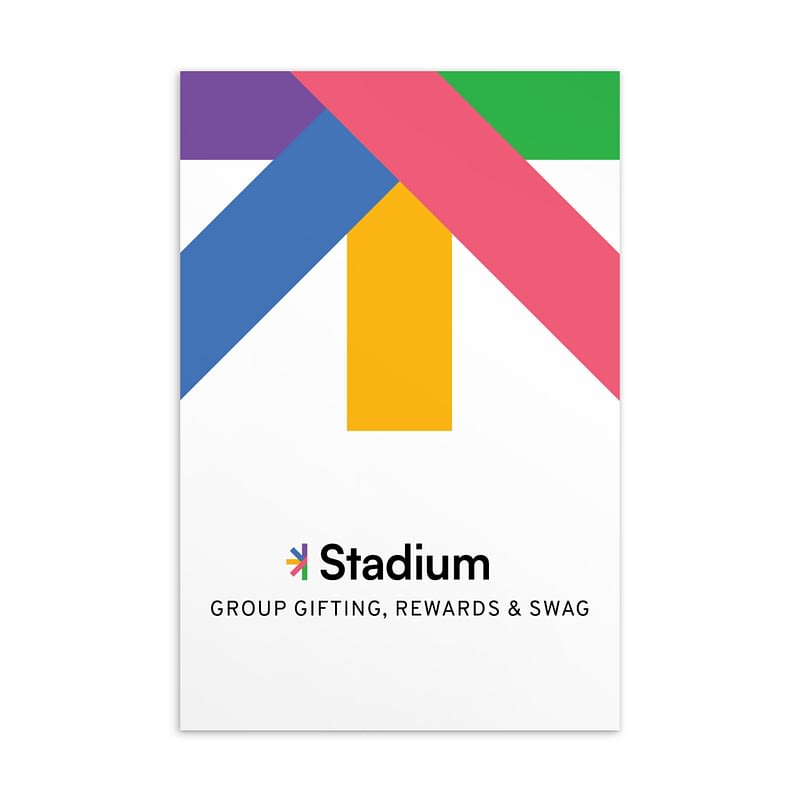Employee Recognition- Benefits, Examples, and Tools
Learn what employee recognition is, why it matters, and how to implement it with tools like Stadium. Includes best practices, types, and real examples.
Pay-as-you-go. No minimums—no subscriptions, no monthly fees.

Quick Summary
Employee recognition is essential to boosting morale, improving retention, and reinforcing your company culture. Learn how to build a modern recognition strategy using Stadium, including types, best practices, case studies, and top tools.
Definition
“Employee recognition is the process of acknowledging and appreciating employees for their individual and team contributions, milestones, behaviors, or performance that align with organizational goals and values.”
It includes both formal systems (like milestone awards or structured peer recognition platforms) and informal moments (like a spontaneous shout-out or thank-you note).
Recognition can come from leaders, managers, or peers and may involve tangible rewards or heartfelt acknowledgment.
Recognition is not just a feel-good practice. It meets psychological needs for validation and belonging, which fuels intrinsic motivation.
Whether you’re trying to build a more inclusive culture, retain top talent, or increase engagement, recognition plays a critical role.
Employee Recognition vs. Alternatives
| Approach | Pros | Cons |
|---|---|---|
| Recognition (non-monetary) | High impact, builds culture, low cost | Needs consistency, can feel intangible |
| Bonuses | Direct reward, easy to understand | Short-term impact, costly, transactional mindset |
| Engagement programs | Holistic improvement, long-term benefits | Harder to measure, slower to influence morale |
Why Employee Recognition Matters
Recognition fuels motivation. Studies show that organizations with strong recognition cultures see:
21% higher profitability
31% lower turnover
41% improved employee engagement
Recognized employees are more productive, stay longer, and feel a greater sense of purpose. In environments where psychological safety and appreciation are prioritized, teams are more collaborative and innovative. Recognition doesn’t just boost morale—it boosts business.
Tool to Power Employee Recognition: Stadium

Stadium is a flexible, automation-ready recognition platform with peer kudos, milestone gifting, branded redemption shops, and analytics.
Key Features
- Peer-to-peer, milestone, manager, and campaign recognition
- Fully branded swag and gifting shops
- 1M+ catalog items, 170+ countries
- Slack/MS Teams integrations
- Budget control and reward tracking
Use Case: Automate employee anniversaries, send points via Slack, let recipients redeem branded gifts—all from one dashboard.
The value of Stadium
Employee recognition Solutions
A whole new set of employee recognition ways to inspire coworkers.
Peer-to-Peer Recognition
See how peer-to-peer recognition drives culture and camaraderie. With Stadium, teammates can easily send shout-outs and reward each other using points and messages.


Explore Stadium’s robust catalog of global rewards, from branded swag to curated gifts. This hub showcases how companies use Stadium to centralize employee rewards and simplify fulfillment
Discover Stadium’s all-in-one recognition software designed to automate kudos, rewards, and milestone campaigns. Seamlessly integrate with Slack or Teams, manage budgets, and empower every team to appreciate each other with ease.


Compare leading recognition tools, including Stadium, Bonusly, and Kudos. See which platform fits your needs based on features like automation, customization, and analytics.
Get an inside look at Stadium’s Kudos engine—where real-time appreciation, gamified redemption, and Slack/Teams integration come together.

Go Further
See what else you can do with Stadium's employee recognition platform
Learn how to track the ROI of recognition programs with metrics like engagement, participation, retention, and budget usage using Stadium’s built-in analytics.
Need inspiration? Find dozens of creative and scalable recognition ideas categorized by team type, budget, and occasion.
Design effective incentive programs that reward performance, boost motivation, and align with business goals. Includes examples for sales, ops, and cross-functional teams.
Understand the common barriers to effective recognition—from inconsistent practices to limited visibility—and how Stadium helps solve them at scale.
Learn to build scalable peer recognition flows using Stadium's Kudos feed, integrations, and redemption shops. Includes examples, templates, and setup tips.
Centralize and scale your corporate reward strategy with Stadium. Great for cross-border teams, budget controls, and custom catalogs.
BOOST YOUR EMPLOYEE RECOGNITION PROGRAM
Best Practices for Recognizing Employees
Follow these principles to make your recognition programs meaningful and impactful:
1. Timely- Don’t wait for performance reviews. Recognize behaviors and wins as they happen. Real-time feedback reinforces desired actions immediately.
2. Specific- Generic praise (“Good job”) doesn’t move the needle. Be specific: “Your idea in the marketing brainstorm helped us reposition the campaign, which improved lead conversions by 25%.”
3. Authentic- Forced recognition can feel hollow. Make it sincere and personal. Even a short note, when genuine, goes a long way.
4. Inclusive- Everyone deserves recognition—not just top performers. Celebrate quiet contributors, support staff, and remote workers. Use tools that support visibility across departments.
5. Aligned With Values- Link recognition to company values (e.g., innovation, empathy). This not only drives culture but helps new hires understand “how we work.”
6. Public and Private Options- Some employees love the spotlight; others don’t. Offer choices—like Slack channels, town hall callouts, or private kudos emails.
7. Peer-to-Peer Recognition- Managers don’t see everything. Empower peers to recognize each other with platforms like Stadium’s Kudos Recognition.
Real-World Examples of Recognition
- Workato: Birthdays at Scale- Workato used a Stadium shop to celebrate birthdays globally with branded swag. This turned into an ongoing recognition stream. 69 orders placed, boosting morale across the U.S., Singapore, and Germany.
- Paperchase: Brand-Centric Rewards- Paperchase built a custom swag shop with its logo on every item. Employees could redeem gifts within their budget. The result? Improved employer brand and seamless recognition for 1,000 recipients.
- Outliant: Global Work Anniversary Gifting- With teams across 13 countries, Outliant used Stadium for work anniversary gifting. Consistent pricing and no minimums made it easy to appreciate every team member.
- My Mountain Mover: 100% Redemption- To boost appreciation, this healthcare team launched a Stadium shop. The result? 100% of recipients redeemed their rewards.
What is employee recognition?
It’s the practice of acknowledging and appreciating employee contributions that support business goals and culture. It can be formal or informal, peer-to-peer or manager-led.
Why is employee recognition important?
Recognition improves engagement, retention, and morale—it helps employees feel valued, which increases their motivation and performance.
How often should I recognize employees?
Recognition should be frequent and timely—weekly shout-outs, monthly wins, and milestone celebrations.
What are low-cost ways to recognize employees?
Try personalized notes, shoutouts in Slack, points-based rewards, or leadership lunches.
What’s the difference between recognition and rewards?
Recognition is the act (e.g., praise); rewards are the item (e.g., gift card, branded merch) associated with that praise.


